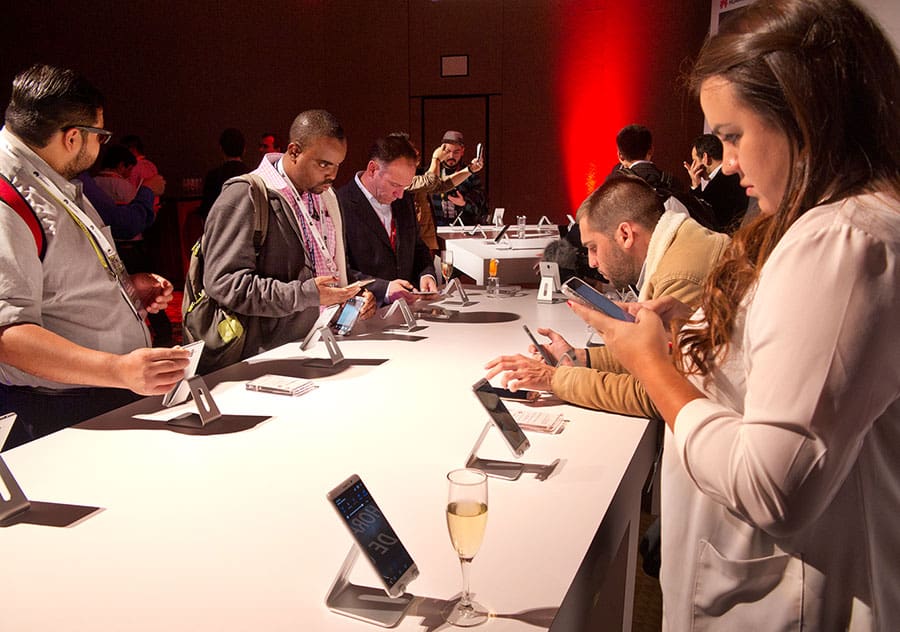
Above: Journalists examine Huawei’s new line of smartphones for 2017 as a special event at Caesar’s Palace in Las Vegas, Nevada. Photo by Mark Lyndersay.
BitDepth#1075 for July 10, 2017
On Friday, Huawei, the Chinese technology company that made its first big splash in smartphone products just five years ago, proved to have outgrown shyness about what it’s achieved on multiple stages at this year’s Consumer Electronics Show in Las Vegas, Nevada.
At a special event for Latin American Media held at Caesar’s Palace, the company introduced its product lineup for 2017 and reflected with broad smiles all around about the successes of 2016.
Richard Yu, CEO of Huawei announced an overall 32 percent increase in revenue in its smartphone business, double digit growth in the sector and shipments up from 108 million to 139 million.
In Latin America, the company sold 12 million smartphones, registering 39 per cent growth in the region with 42 per cent improvement in sales.
Having registered its presence as a solid and growing third place contender in the smartphone market, Huawei has now set its sights on being one of the top two.

Richard Yu, CEO of Huawei, introduces the Mate 9 to journalists from Latin America at a special event at Caesar’s Palace in Las Vegas Nevada. Photo by Mark Lyndersay.
“Five years ago,” Yu said, “we were nothing.”
The company has a soft spot for emerging markets, where it got its start in the smartphone business and last week the company flew 67 journalists from the region to share in its success at its CES presentations and lavish show booth.
The company claims 78 per cent brand recognition in Latin America, but there’s clearly room for improvement and it clearly wants to amplify that conversation (David Moheno responds to questions about the Caribbean market here).
Huawei’s presence may have been smaller than Samsung’s at CES, but its rival was showing everything it sold. Huawei set aside its considerable telecommunications hardware business and even consumer focused products like its successful line of home routers to focus, with laser efficiency, on its growing smartphone line.
That product grouping is now led by the Mate 9, a sleek and updated edition of the company’s large handset for upscale general use. The Mate 9 now gets an updated version of the dual lens technology that Huawei developed with Leica and introduced in April last year, with tweaks to the software that are focused more on general consumers than pro photographers and the market leading Kirin 960 processor.
The company has sold 100 million of its Kirin mobile chipsets and points to market leading performance from the newest version of the processor.
The new chip and GPU deliver an 18 per cent improvement in chip performance with 15 per cent better energy efficiency and an even more dramatic 180 per cent improvement in GPU performance with a 40 per cent upgrade in energy efficiency.
The new Mate 9 also offers fast charging with a special (included) adapter, delivering 58 percent of the device’s charge capacity in 30 minutes. The phone will run in normal operation for a day on a 20 per cent charge of its 4000mah battery.
Sitting just below the new Mate 9 is the Mate 9 Lite, followed by the Nova and the P9 Lite, 2017 edition. Each device takes an estimated 10-15 percent cut in overall performance specs as you move down the line.
There is a parallel Honor brand, which delivers versions of Huawei’s devices in a form factor and style designed for active younger users.
Huawei’s plans for 2017 are for growth for its smartphone line and the company is keen to consolidate the gains it has made in Europe and Latin America.
It is making big investments in machine learning to make its products predictive as well as responsive and is forging mutually beneficial relationships with complementary services like Google and Amazon to build more differentiation into the feature profile of its products.
“The industry is consolidating,” said Mr Yu.
“I believe that in the next two to three years only two suppliers will survive.”
Huawei intends to not just survive, but to thrive in a fiercely competitive market.


